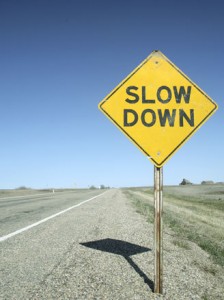S.L.O.W. down technique with tips on using reorganizational healing tools
 Hurry Up and Slow Down!
Hurry Up and Slow Down!
Ever feel that way? Get to that yoga class. Squeeze in talking to your family. Hurry up and meditate. Grab a meal. Sleep fast.
Most of us crave enjoying every moment, feeling good in our body, connecting with nature, experiencing community, enjoying food, music, and loved ones. How can we do it all? It’s not as far out of your reach–think S.L.O.W.
In each moment we have an opportunity to engage deeply or speed through. Often we think more is more, when more is really less. Multi-tasking, smart phones, Facebook, and our cultural norms have put us on the fast track 24/7. Step off the track. You can choose to do it. You may have found yourself taking a stand about a particular issue in your life or seen others taking a stand about something they believed in. Be radical! S.L.O.W. down. Do it for a month, a year, or everyday for the rest of your life.
David Hochman’s article, Not So Fast is a powerful reminder of the value of this simple approach to living S.L.O.W. Here is the technique he used to begin this practice with some tips for how you can use reorganizational healing tools we teach and use in the office to augment.
S is for “Savor.” – “Truly appreciate the passing hours and minutes rather than counting them.” Notice something that is different or novel to help engage in the time passing – a sound, smell, color, or depth you haven’t experienced before.
L is “Listen to your inner clock.” In a world of fast talkers, fast drivers, and fast tempers, it’s essential to maintain your own ideal speed. Some moments demand quick action and thinking. Most don’t.” Check in with your body by using Somato Respiratory Integration or an entrainment to reconnect with your natural rhythm and pace. Remind your body of its own internal clock.
O is “Others before technology” – “No texting under the dinner table, no checking email at night or before breakfast, no TV when we could be talking, and, horror of horrors, no Facebook or Twitter, period. Those time sucks were draining more precious time than I cared to admit, and toggling between real-life tasks and silly updates was causing productivity losses economists refer to as “switching costs.” Notice when technology is taking us out of connection and the engaging with people. Do something different. What are all the reasons you tell yourself you can’t do this?
W was the ultimate test of every activity and experience: “Will it matter a year from now?” “This not only made me feel better about little annoyances (“Have a nice day, Mr. Telemarketer!”) and bigger ones, like when my hard drive crashed during week two, it also helped sharpen decision-making.” When we feel like something important to us or someone else will “be complicated”, try this question out and see if suddenly it’s a no-brainer and you’re motivated to just do it. Or it’s as clear the other way that it’s not worth it.
Here is the article link if you’d like to explore more. It’s worth slowing down to read.
